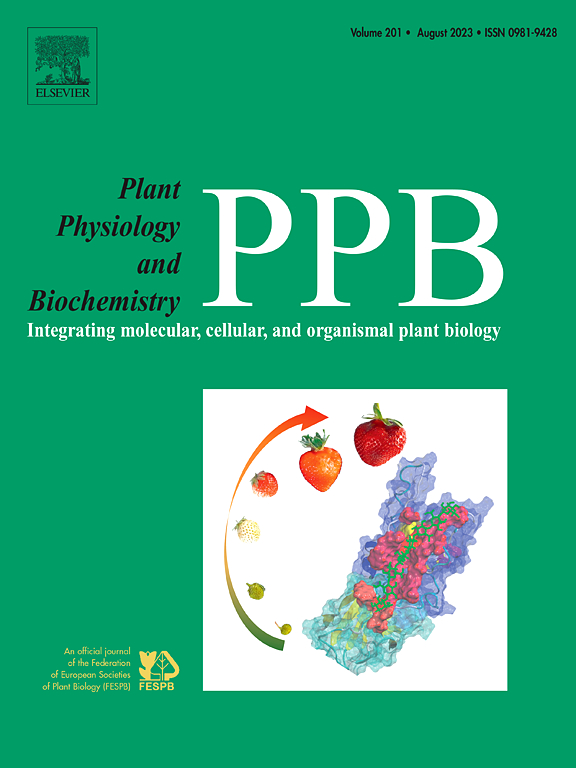兼性CAM植物盐度胁迫恢复过程中RubisCO和PEPC的差异表达
IF 5.7
2区 生物学
Q1 PLANT SCIENCES
引用次数: 0
摘要
我们之前的工作表明,模式兼性CAM植物(Mesembryanthemum crystinum L.)在盐分胁迫退出后需要不到48小时的时间来完全重新排列其光合机构并完全恢复光合量子效率。我们的最新发现表明,并不是这种高度可塑的光合作用器官的所有方面都经历了如此迅速的变化。胁迫依赖性PEPC1蛋白在盐分胁迫消退(-NaCl)植株中连续两天仍有表达,而在对照(C3)植株中未见表达。脱盐植株PEPC活性有限,其13C识别能力显著高于维持盐(+NaCl)植株。有趣的是,在蛋白质水平上RubisCO表达的变化似乎并不是应激消退后快速改变的一部分。在去除胁迫后的连续2天内,大RubisCO亚基在盐胁迫(+NaCl)和胁迫退出(-NaCl)植物中的表达量保持在相似水平,而显著低于未胁迫(C3)对照植物。另一方面,在胁迫退出(-NaCl)后1天,脯氨酸水平下降到未处理(C3)对照植株的水平。相反,应激源去除对恢复植物氧化应激相关损伤的影响很小。此外,撤回渗透胁迫对生长速率影响不大。尽管胁迫解除(-NaCl)植株的相对含水量(RWC)显著高于盐胁迫(+NaCl)植株,但生长没有明显加快。总的来说,这项研究为盐度胁迫下的恢复过程提供了新的见解。本文章由计算机程序翻译,如有差异,请以英文原文为准。
Differential expression of RubisCO and PEPC during the salinity stress recovery of facultative CAM plants
Our previous work demonstrated that the model facultative CAM plant (Mesembryanthemum crystallinum L.) requires less than 48 h to fully rearrange its photosynthetic apparatus and complete recovery of photosynthetic quantum efficiency following salinity stress withdrawal. Our latest findings show that not all aspects of this highly plastic photosynthetic apparatus undergo such rapid changes. Although significantly lower than in salinity-sustained (+NaCl) plants, the stress-dependent PEPC1 protein remained expressed in salinity stress-withdrawn (-NaCl) plants for two consecutive days after stress removal, whereas its expression was undetectable in control (C3) plants. Limited PEPC activity in salinity-withdrawn plants was reflected in a significantly higher 13C discrimination than in salinity-sustained (+NaCl) plants. Interestingly, changes in RubisCO expression at the protein level did not appear to be part of the rapid modifications following stress withdrawal. For two consecutive days after stress removal, the large RubisCO subunit remained expressed at similar levels in both salinity-stressed (+NaCl) and stress-withdrawn (-NaCl) plants, while being significantly lower than in unstressed (C3) control plants. On the other hand, one day after stress withdrawal (-NaCl), proline levels dropped to those observed in salinity-untreated (C3) control plants. Conversely, stressor removal had only a minor impact on oxidative stress-related damage in recovering plants. Moreover, withdrawing osmotic stress had little effect on the growth rate. Despite a significantly higher relative water content (RWC) in stress-withdrawn (-NaCl) plants compared to those that remained under salinity stress (+NaCl), growth did not noticeably accelerate. Overall, this study provides new insights into the recovery process from salinity stress.
求助全文
通过发布文献求助,成功后即可免费获取论文全文。
去求助
来源期刊
CiteScore
11.10
自引率
3.10%
发文量
410
审稿时长
33 days
期刊介绍:
Plant Physiology and Biochemistry publishes original theoretical, experimental and technical contributions in the various fields of plant physiology (biochemistry, physiology, structure, genetics, plant-microbe interactions, etc.) at diverse levels of integration (molecular, subcellular, cellular, organ, whole plant, environmental). Opinions expressed in the journal are the sole responsibility of the authors and publication does not imply the editors'' agreement.
Manuscripts describing molecular-genetic and/or gene expression data that are not integrated with biochemical analysis and/or actual measurements of plant physiological processes are not suitable for PPB. Also "Omics" studies (transcriptomics, proteomics, metabolomics, etc.) reporting descriptive analysis without an element of functional validation assays, will not be considered. Similarly, applied agronomic or phytochemical studies that generate no new, fundamental insights in plant physiological and/or biochemical processes are not suitable for publication in PPB.
Plant Physiology and Biochemistry publishes several types of articles: Reviews, Papers and Short Papers. Articles for Reviews are either invited by the editor or proposed by the authors for the editor''s prior agreement. Reviews should not exceed 40 typewritten pages and Short Papers no more than approximately 8 typewritten pages. The fundamental character of Plant Physiology and Biochemistry remains that of a journal for original results.

 求助内容:
求助内容: 应助结果提醒方式:
应助结果提醒方式:


